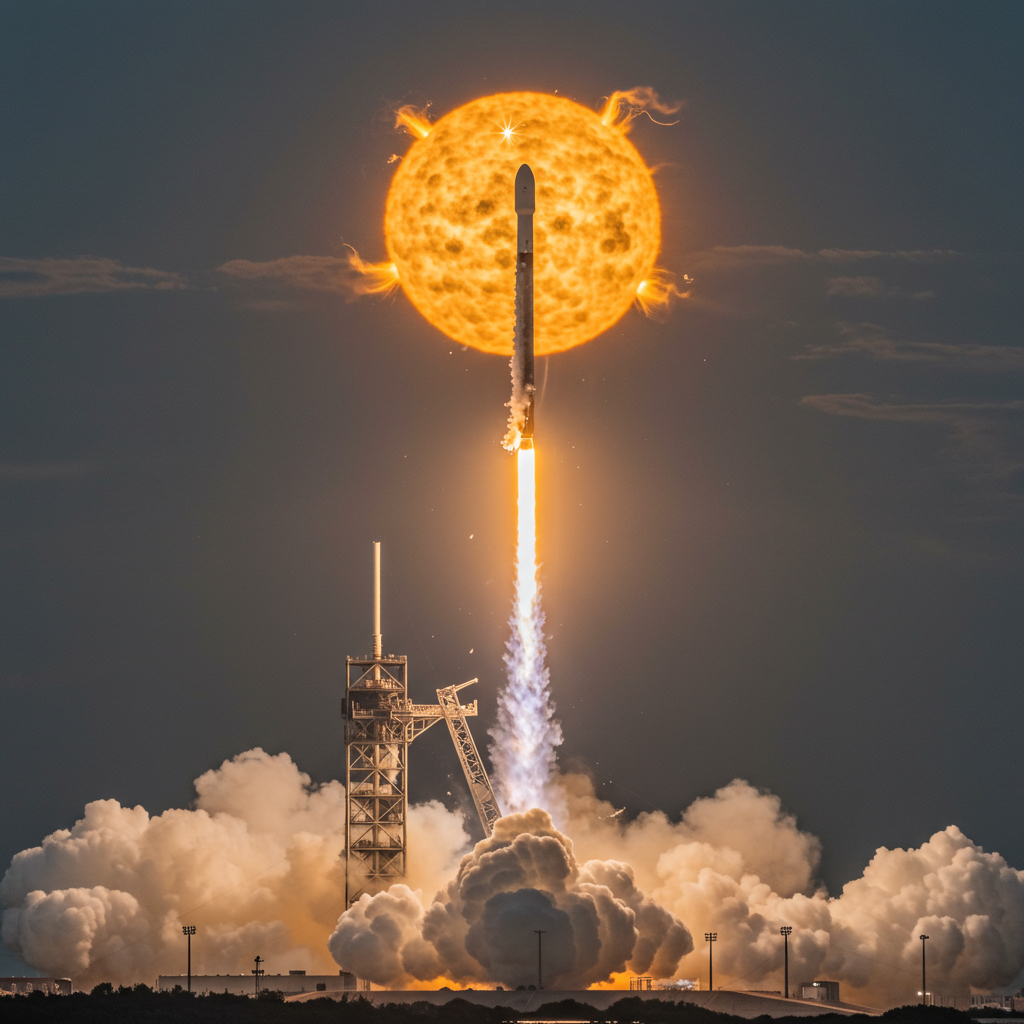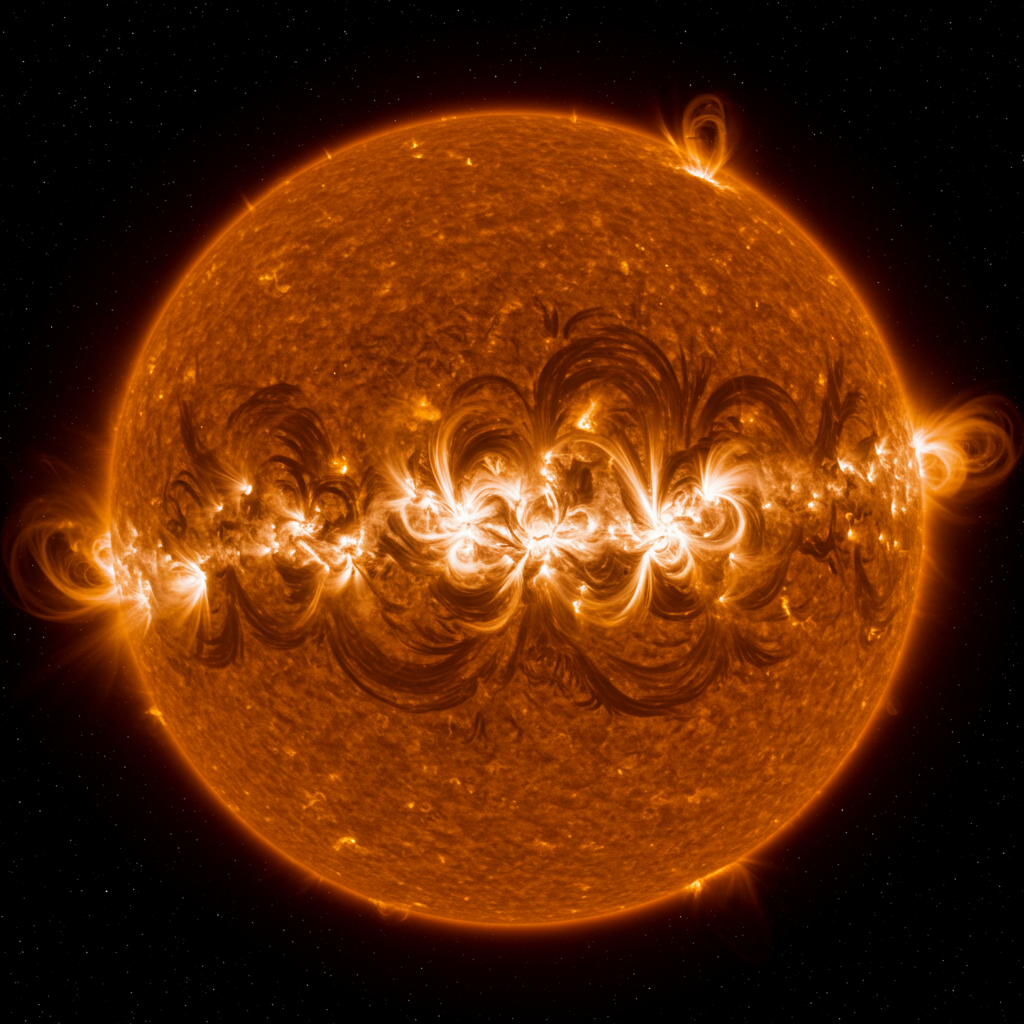Humanity’s quest to understand the universe takes a momentous leap forward with an upcoming triple-header mission, poised to redefine our understanding of the Sun’s profound influence on our solar system. On September 24, 2025, a powerful SpaceX Falcon 9 rocket is scheduled to lift off from NASA’s Kennedy Space Center in Florida. This launch carries three vital spacecraft, each dedicated to unraveling the mysteries of the Sun’s energy and its far-reaching impacts. This groundbreaking collaboration between NASA and the National Oceanic and Atmospheric Administration (NOAA) promises to deliver unparalleled data, crucial for protecting Earth and paving the way for future deep-space exploration.
Unveiling the Sun’s Dynamic Influence
The Sun, our life-giving star, is a dynamic powerhouse that continuously emits a stream of charged particles known as solar wind. It also triggers energetic events that create “space weather,” a complex interplay of changing conditions in space. These phenomena can have significant consequences for our planet, technology, and astronauts. The three missions aboard the Falcon 9 are specifically designed to study these effects. They will track the solar wind from its origins at the Sun’s corona to the distant boundaries of our solar system, billions of miles away. Understanding this invisible yet powerful force is paramount for our modern, technologically reliant society.
IMAP: Mapping the Interstellar Frontier
NASA’s Interstellar Mapping and Acceleration Probe (IMAP) is a cornerstone of this ambitious undertaking. Its primary goal is to map the boundary of the heliosphere, the protective bubble created by the solar wind that shields our solar system from harmful galactic cosmic rays. IMAP will also study the fundamental processes of particle acceleration. By analyzing particles from the Sun and those originating from outside our solar system, IMAP will provide crucial insights into how these particles are accelerated and transported. This knowledge is essential for comprehending the space environment that future astronauts will traverse on journeys to the Moon and Mars.
Carruthers: Observing Earth’s Protective Shield
The Carruthers Geocorona Observatory, another crucial NASA mission, will focus on Earth’s exosphere and geocorona. The geocorona is a vast, tenuous cloud of hydrogen atoms surrounding our planet, extending far beyond the atmosphere. It’s an important component of Earth’s upper atmosphere. Carruthers will provide unprecedented observations of this region, helping scientists understand how it interacts with the solar wind. Variations in the geocorona can offer clues about the impact of solar activity on Earth’s atmosphere. This data will enhance our models of Earth’s protective magnetic field and its response to space weather events.
SWFO-L1: Early Warnings for Space Weather
NOAA’s Space Weather Follow On–Lagrange 1 (SWFO-L1) spacecraft represents a vital advancement in space weather forecasting. Positioned at the Lagrange 1 point, approximately one million miles closer to the Sun than Earth, SWFO-L1 will serve as an early warning system. From this strategic vantage point, it will continuously monitor the solar wind and coronal mass ejections (CMEs) as they leave the Sun and head towards Earth. By providing advance notice of these powerful solar events, SWFO-L1 will allow scientists and operators on Earth more time to prepare for potential disruptions. This proactive approach is critical for mitigating risks to satellites, communication systems, and power grids.
The Critical Role of Solar Research
These solar missions represent more than just scientific curiosity; they are an investment in our collective future. The data gathered will have direct applications, from safeguarding essential infrastructure to enabling humanity’s expansion into the cosmos. Space weather, driven by solar activity, can cause geomagnetic storms that disrupt radio communications, degrade GPS signals, and even induce currents in power grids, leading to widespread outages. Understanding these phenomena allows us to build resilience into our technological systems.
Protecting Our Connected World
In our increasingly interconnected world, reliance on satellite technology and robust power infrastructure has never been greater. A severe space weather event could have cascading effects, impacting everything from airline navigation to financial transactions. The space weather missions like SWFO-L1 are designed to give us the foresight needed to manage these risks effectively. Improved forecasts mean better protection for astronauts, safer satellite operations, and stronger national infrastructure. This preventative capacity is a direct benefit of investing in advanced solar observation.
Powering Future Deep Space Exploration
Just as the International Space Station (ISS) has served as an unparalleled proving ground for 25 years, fostering international collaboration and enabling thousands of scientific experiments vital for human adaptation to space, these new solar missions are equally critical for future deep-space endeavors. The ISS has demonstrated the power of sustained human presence in microgravity, advancing our understanding of life sciences, material science, and technology development. Over 280 individuals from 23 countries have contributed to its success, conducting over 4,000 experiments. Similarly, understanding the solar environment is fundamental for the ambitious Artemis missions, which aim to return humans to the Moon and eventually to Mars. Astronauts venturing beyond Earth’s protective magnetosphere will be exposed to higher levels of solar and galactic radiation. IMAP’s data on cosmic rays and solar particles will be invaluable for developing better radiation shielding and operational procedures, ensuring the safety and success of these historic journeys. The insights from these new solar probes will directly support the legacy of research and preparation initiated by the ISS, facilitating humanity’s journey further into the cosmos.
A Collaborative Leap in Space Science
This 3-in-1 launch is a testament to the power of interagency collaboration and international scientific partnership. NASA and NOAA, working alongside commercial partners like SpaceX, exemplify the shared commitment to advancing our knowledge of the space environment. Such joint ventures allow for a synergistic approach, pooling resources and expertise to tackle complex scientific challenges that no single entity could address alone. This collaborative spirit, reminiscent of the global efforts behind the International Space Station, ensures that the data collected will be comprehensive and widely accessible, fostering a new era of discoveries in heliophysics.
The Technology Behind the Launch
The SpaceX Falcon 9 rocket, known for its reliability and reusability, is the chosen vehicle for this critical launch. Its ability to deliver multiple payloads to precise orbits makes it ideal for such a complex mission profile. Lifting off from the iconic Kennedy Space Center, the Falcon 9 will propel these spacecraft towards their designated operational positions, from which they will begin their long-term observations. The precision engineering and advanced propulsion systems involved are a tribute to modern aerospace capabilities, enabling humanity to extend its senses further into the solar system than ever before. This technological prowess underscores the commitment to scientific excellence.
Frequently Asked Questions
What exactly is space weather and why is it important for daily life?
Space weather refers to the changing environmental conditions in space, primarily driven by the Sun’s activity. This includes solar flares, coronal mass ejections (CMEs), and the continuous stream of particles known as solar wind. It’s crucial because severe space weather events can disrupt or damage critical infrastructure on Earth, such as power grids, satellite communications, GPS systems, and even affect high-altitude flights. For instance, strong geomagnetic storms can induce currents in long power lines, potentially causing blackouts, or interfere with radio signals vital for navigation. The missions launched on September 24, 2025, are designed to provide better warnings and understanding of these phenomena.
How do the three missions work together to study the Sun’s influence?
The three missions — NASA’s IMAP, NASA’s Carruthers Geocorona Observatory, and NOAA’s SWFO-L1 — are complementary, providing a comprehensive view of the Sun’s impact. SWFO-L1 acts as an early warning system from a point closer to the Sun, monitoring solar wind and CMEs directly as they begin their journey. IMAP then studies the interaction of these solar particles with the interstellar medium at the outer reaches of our solar system, mapping the heliosphere. Finally, Carruthers focuses on how Earth’s own protective geocorona responds to the incoming solar wind and space weather. Together, they create a complete picture, from the Sun’s surface to the edge of our solar system and its direct effects on Earth.
What are the long-term benefits of these solar missions for humanity?
The long-term benefits of these solar missions are extensive, impacting both our current technological society and future endeavors. Firstly, improved space weather forecasting will enhance the resilience of our power grids, telecommunications, and satellite operations, preventing costly disruptions and safeguarding essential services. Secondly, the data on solar radiation and cosmic rays is vital for planning safer human missions to the Moon and Mars, as it will inform the design of better radiation shielding for spacecraft and astronauts. Thirdly, a deeper understanding of the Sun’s processes contributes to fundamental scientific knowledge, helping us unravel the mysteries of our star and its place in the universe, ultimately benefiting all of humanity through advanced scientific discovery and technological innovation.
Conclusion: Charting a Brighter Future
The upcoming September 2025 launch of these three groundbreaking solar missions marks a pivotal moment in space science. By providing unprecedented insights into the Sun’s dynamic behavior and its influence across the solar system, these missions will arm humanity with critical knowledge. From safeguarding our planet’s vital infrastructure to paving the way for safer deep-space exploration, the data gathered will enhance our resilience and broaden our cosmic horizons. This collaborative endeavor, leveraging advanced technology and scientific expertise, underscores our collective commitment to understanding the universe we inhabit. The journey to unlock space weather’s secrets is set to begin, promising a future illuminated by discovery and protection.




